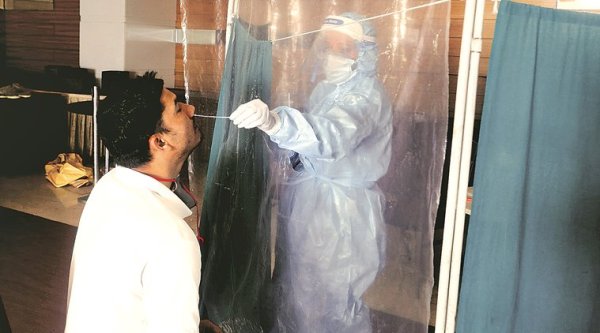 Till five days ago, Jhajjar district was in green zone and had not reported any COVID case since March 4. (Representational image)
Till five days ago, Jhajjar district was in green zone and had not reported any COVID case since March 4. (Representational image)
While Haryana’s two districts of Sonipat and Faridabad were declared red zones by the Ministry of Health and Family Welfare in its weekly list on red, orange and green zones issued on Thursday, Jhajjar district has fast emerged on top with maximum COVID cases. Till five days ago, Jhajjar district was in green zone and had not reported any COVID case since March 4.
With the sudden surge in COVID cases in districts bordering Delhi due to which Haryana has shut its four borders in Gurugram, Sonipat, Faridabad and Jhajjar, state’s Home Minister Anil Vij told The Indian Express that “nobody shall be allowed to enter Haryana without a COVID test. Be it people carrying essential services or those with lockdown passes, unless a person tests negative on the state’s border, he/she will not be allowed entry into Haryana”.
As on date, Jhajjar district recorded 28 COVID cases (including four fresh cases in the last 24 hours), the majority of which are related to Delhi’s Azadpur Mandi. The state’s total count on Friday touched 357 COVID cases out of which 112 are active patients.
Jhajjar district is followed by Sonipat with 22 active COVID cases and Gurugram with 19 active cases while there are 18 active cases in Faridabad district, besides eight cases in Panipat, six cases in Nuh, two each in Ambala, Hisar and Palwal, and one each in Rohtak, Bhiwani and Panchkula.
With the fresh surge in COVID cases in the state, the recovery rate was recorded at 67.51 per cent while the fatality rate was 1.12 per cent according to the state government’s Friday evening health bulletin. The COVID-19 positive rate in the state was recorded at 1.27 per cent while the case-doubling rate in Haryana was 20 days. So far, four COVID patients have lost their lives in Haryana.
Haryana Chief Secretary Keshni Anand Arora, while presiding over the Crisis Coordination Committee meeting with field officers on Friday evening, explained the various measures to be taken while allowing the movement of the stranded migrant labour within and outside the state.
“One of the major measures is with regard to medical checking/screening of these persons meticulously to contain the spread of coronavirus. Apart from this, a strict vigil be maintained in the vegetable mandis by way of proper thermal scanning and maintaining social distancing norm. Foot sanitisation at public places be also ensured,” Arora directed the officers.
“State boundaries have been sealed with neighbouring states. Therefore, a strict vigil is required on these borders to ensure that no person from within the state or outside the state can move out or in without proper medical screening,” Arora added.
The government on Friday also asked village sarpanches, lambardars, gram sachiv to keep a close vigil on every individual, be it migrant labourers, truck drivers, pilgrims who are entering their respective areas, and added that all those should be tested thoroughly and quarantined either in institutions or at home. Similarly, in cities, mayors have been asked to do the same exercise wihin their respective jurisdictions.
All the Deputy Commissioners were directed to evolve a mechanism in which an officer from each district should immediately share the details of any migrant labourer entering the other district, so that the other district should ensure that medical testing of such labourers is done.
Additional Chief Secretary (Health and Family Welfare) Rajeev Arora said, “To ensure checking of every driver entering Haryana, initially special medical teams would be deputed on every toll plaza at four national highways connecting with the state. The medical teams have been directed to conduct a thorough screening of every truck driver to ensure that COVID-19 infection chain is broken. The team would work in two shifts. Apart from this, medical testing at those dhabas on National Highways that would be allowed to open would also be done. In cases of emergency where any driver is found with COVID-19 symptoms, then samples would be taken. Apart from this random sampling of health workers, sanitation workers, police personnel and other employees working in various departments involved in essential services is being conducted.”